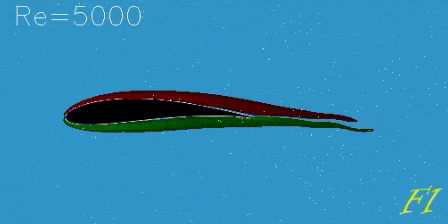Since the air (and water) viscosity is small, in many flows encountered in everyday life the Reynolds number Re is very large. This means that viscous diffusion of vorticity is a weak effect as compared to the vorticity advection. Consider for example the flow past an aerofoil at high Re. Far upstream, the flow is uniform, and therefore the fluid particles are not rotating there. Accordingly, the vorticity is zero far upstream. If we neglect viscous diffusion as compared to the advection then this zero vorticity will be carried with the fluid particles into the entire flow domain. In the video the areas of large vorticity are marked with red colour where the vorticity is negative and with green colour where the vorticity is positive. The areas where the vorticity is large are, however, relatively thin if the Reynolds number is large. Then, in the bulk of the flow the vorticity can be assumed to be zero. Flows with zero vorticity are called potential flows. Since it turns out that the flow is potential in a large part of the flow domain, potential flows are worth studying. Fortunately, potential flows are much simpler than other flows.
The thin areas near the aerofoil where the vorticity is not small are called boundary layers, and downstream of the aerofoil they are called the wake. Boundary layers will be considered separately.
Sometimes boundary layers separate from the body surface, and then vorticity fills a large part of the flow domain even when the Reynolds number is large. The phenomenon of separation will also be considered separately in more detail later, but an overview of separation phenomenon is already available.

